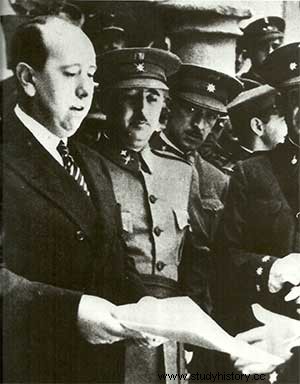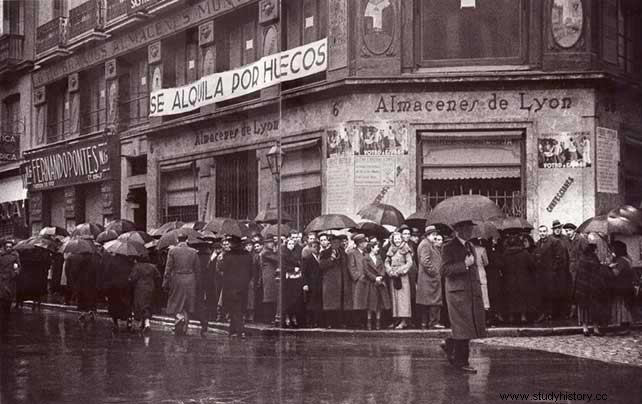The conservative biennium spanned from November 1933 to February 1936. In the general elections held in November 1933 , in which for the first time, as a result of the 1931 Constitution, women exercise their right to vote, the CEDA wins. The result, however, is not broad enough to govern alone. In this way, Gil Robles is not called by Alcalá-Zamora (to whom this prerogative corresponds as President of the Republic) to head the Government. Mistrust of Gil Robles' intentions motivated the decision. The appointee will be Lerroux as the Radical Republican Party agrees to govern with the support of the CEDA.
For the radicals of Lerroux, the alliance with the CEDA only tries to attract the Catholic right to the republican cause; for Gil Robles it is about gaining control of the Government - even without belonging to it - while waiting to be called to govern. The coincidences between the Radical Party and the CEDA allow a reversal of numerous reforms undertaken in the reformist biennium:the clergy once again collect salaries from the State, religious schools do not close their doors... In addition, the coup plotters of 1932 are amnestied. The differences, for their part, impede the reform of the political system. The biggest setback is for the Socialist Party, whose reformism, far from strengthening its project, relegates it electorally. Fearful that authoritarianism will end its suppression, as has happened in Italy or Germany, the most leftist sector, led by Largo Caballero, radicalizes its revolutionary discourse.
October 1934 Revolution
The inclusion in the executive of three CEDA ministers, in October 1934, after different crises within the Government, unleashed a revolutionary uprising led by the PSOE and the UGT (together with the Esquerra Republicana de Catalunya and the Communist Party) . The memory of what happened in Germany, where Hitler legally came to power a year earlier, rapidly dismantling the democratic system, or in Austria, where Dollfuss has finished off the socialists in the name of a Catholic movement similar to the CEDA, is present for the rebels. The CNT, except in Asturias, remains on the sidelines. The news of a new government with the participation of the CEDA gave rise, as planned, to a general strike with varying degrees of support throughout the country but quickly suffocated. In Catalonia, President Companys proclaimed the Catalan State for a few hours, surrendering shortly afterwards. Despite failing in Madrid, Catalonia and the Basque Country, the conflict extends to Asturias, where the revolutionaries take control of the entire province, including Oviedo, its capital. To put an end to the uprising, the intervention of the army is necessary. African troops, under the command of General Franco, put an end to the insurrection. More than a thousand deaths, including the executions of both religious by the revolutionaries and of these by the forces of order, make up the balance of the conflict, the first approximation to what will be a scenario of total war just two years later.

Crisis of the Conservative Biennium
The inclusion of the CEDA in the Government does not cause the anticipated involution, but it makes clear its scarce connection with the republican project. In the months following the Asturias revolution, there is also no perceptible government plan beyond the repression of the revolutionaries or the attempts to incriminate Azaña in the facts. The discussions in Parliament hide their legislative infertility. Gil Robles, appointed Minister of War in May 1935, placed some of the generals disaffected with the regime (Mola, Franco, Fanjul...) in the most prominent positions in the army. Throughout 1935 the Radical Party enters into a deep crisis affected by some corruption scandals (the granting of a license to a type of roulette called straperlo -a term that would be added to Spanish, estraperlo, as a synonym for black market- and the Nombela affair, on supply contracts for the army). Alcalá-Zamora resisted giving the Government to Gil Robles and tried, in December, a personal solution by handing it over to Manuel Pórtela Valladares. The pressures received from all the parliamentary groups ended with the dissolution of the Cortes and the calling of the elections of February 1936.

1936 elections
Both the right and left groups form common lists to group the vote. The CEDA, fearful of not obtaining an absolute majority, organizes the National Front. For their part, the republicans of Azaña and the socialists, joined by the communists, are grouped around the Popular Front. The campaign takes place in a hostile environment. The result (in percentages of votes, not in seats) is the closest:the Popular Front obtains 34.3% of the votes (which means more than 250 seats), while the National Front, for its part , reaches 33.2% of the vote (barely 125 deputies). The victory of the Popular Front supposes the immediate liberation of the prisoners of the October revolution. After the elections, Azaña formed a government made up exclusively of republicans, without the presence of socialists.

Conflicts of the new Government
In April 1936, Alcalá-Zamora was dismissed from his position as President of the Republic (for having dissolved the Cortes twice, as provided for in the Constitution), and Azaña was elected with the abstention of the right . In the months between the victory of the Popular Front and the start of the war, public order conflicts are constant:the revolutionary groups initiate a campaign of strikes, land occupations and attacks on religious buildings; For their part, the Falangists insist on provoking disturbances and committing attacks against militants from other parties and forces of order. In March 1936, the attack by Falangists against Jiménez de Asúa, a socialist intellectual and one of the fathers of the 1931 Constitution, which caused the death of his escort a few days later, led to the banning of the Falange and the arrest of his political junta, including José Antonio.
Conspiracy and coup
The polarization and the climate of confrontation increase in the spring of 1936, when a sector of the army has already advanced the conspiracy for a coup d'état. General Mola, who has been stationed since March in the military government of Pamplona, where the Popular Front government has transferred him due to distrust of him, initiates a series of contacts and draws up various guidelines and instructions that outline an action, with support of civil sectors, aimed at overthrowing the Government. Despite being, in principle, a military maneuver, the conspirators established communication with the Carlist movement, with the Falange, with the CEDA, with Acción Española, etc. Come summer, the uprising, lacking some nuances, is more or less ready. The clashes in the streets, in which groups of leftists and Falangists settle their differences, continue to escalate.
On July 12, José Castillo, a lieutenant in the Assault Guards and a socialist sympathizer, was killed in a terrorist attack. In retaliation, hours later, the leader of the monarchist right, José Calvo Sotelo, is assassinated. The funerals of both give rise to scuffles between left and right radicals in the center of Madrid. The Government, oblivious to the conspiracy launched by Mola, tries to solve the problem by re-establishing public order. However, he will not have time for almost anything when the coup d'état secretly prepared in the previous months by an important sector of the army begins.
